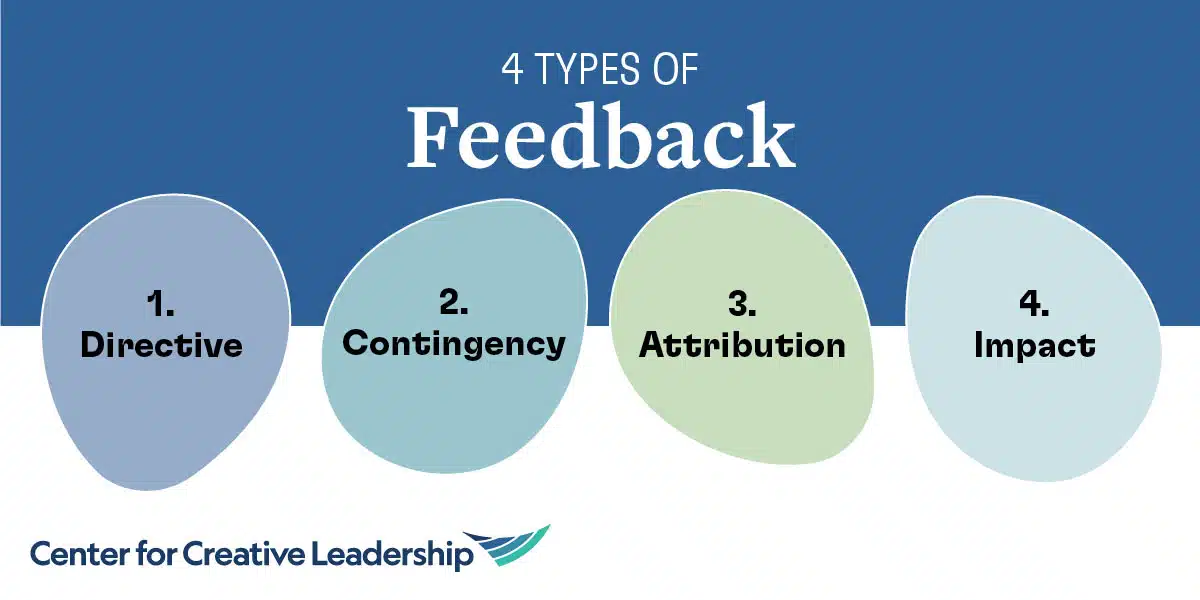Why Giving Feedback Is Important
Feedback is sort of a necessary evil. No one particularly likes to listen to what they’re doing wrong, and often the words are difficult or confusing to hear. And giving feedback isn’t especially easy, either. But as a leader or coach, it’s your job to know how to give feedback, as constructive suggestions can help your direct reports and colleagues succeed. So make sure you understand what it takes to coach people.
Whatever your style or your company’s system, chances are that performance reviews are less-than-satisfying events for you and your direct reports. But learning how to give effective feedback and avoiding common feedback mistakes can make the difference between a meaningless (or disastrous) review and a constructive coaching conversation.
Feedback is one of the most important elements of successful performance reviews because it engages the employee in the conversation and puts the spotlight on key issues. In fact, we believe giving effective feedback is the key to improving your talent development.
If you understand the 4 types of feedback, and which one is most effective to start with, giving feedback will feel easier, and your reviews will improve.
What Is Effective Feedback?
Effective feedback is developmental. It gives recipients specific, direct, and constructive information to help them understand exactly what they did in a particular situation and the impact that behavior had on others. Giving effective feedback is the first step in helping others understand (and address) how their behaviors are affecting their performance.
The 4 Types of Feedback
Which Seems Most Effective to You?
Virtually all feedback can be classified as one of these 4 types:
- Directive
- Contingency
- Attribution
- Impact
- Directive feedback tells someone what to do, even if you’re phrasing it “nicely.” For example, “I suggest that you make priorities clearer to your team.”
- Contingency feedback gives a future consequence: “If you keep interrupting people in meetings, they’ll stop cooperating with you.”
- Attribution feedback describes someone or their actions in terms of a quality or label, as in “You’re a good communicator” or “You’re undisciplined.”
- Impact feedback informs the receiver about the effect their actions have had on other people or on the organization. Impact feedback is important in performance reviews because it can shed light on something your direct report never knew or thought about. It gets at why their behaviors are either working or not working. An example of impact feedback is: “Team members were confused, and I felt frustrated.”
You’ll be better at giving effective feedback if you’re skilled at using all 4 types of feedback for the right times and for the right reasons. You’ll be even better with lots of practice.
Why Impact Feedback Is the Most Effective Type of Feedback
It’s important to remember that you can’t control how someone feels about or reacts to feedback. Different people will perceive the same situation in different ways. You can’t “make” someone like or agree with what you’re saying, but you can increase the chances that your feedback will be well received and not rejected by learning how to give feedback effectively.
The recipient of feedback is more likely to take feedback well if it isn’t authoritative. If the feedback giver is perceived as leveraging positional power or as commanding, dominating, arrogant, or self-centered, the message will be lost. The recipient of the feedback is likely to be defensive or argumentative — or passively accept what you say, but resent the feedback and act in counterproductive ways later.
Among the 4 types of feedback, impact feedback is the most effective to start with because it informs a person about the results of their behavior without dissecting the details, assuming motivation, or placing blame. Try using our widely recognized Situation – Behavior – Impact model to give feedback and explore intentions, making the feedback a two-way discussion.
Impact feedback isn’t authoritative — you aren’t telling a person what to do, setting forth consequences, or judging. Instead, impact feedback informs the receiver, empowers them, and increases the chance they’ll decide to accept the message.
Impact feedback is a great way to start a conversation and set the stage for more authoritative feedback if it’s needed. Once the feedback receiver realizes the impact of their behavior, they’re more receptive to prescriptive aspects of authoritative forms of feedback.

Giving feedback to others about their performance is a key developmental experience. Learn how to make the feedback you give even more effective so that others are more likely to hear and benefit from your message.
How to Give Feedback: 10 Do’s & Don’ts
1. Discuss actions without judgment.
Do: Provide feedback that helps and supports employees. Feedback is about addressing specific actions — it’s not about fixing employees.
Don’t: Judge individuals. This can make people feel defensive by sending the message that only you know what’s right or wrong.
2. Make sure the feedback is clear.
Do: Present clear and honest feedback, whether it’s negative or positive. If you want to encourage someone to repeat productive behaviors, also tell them what’s going well so they can keep doing it.
Don’t: Offer generalized, clichéd catchphrases that are vague.
3. Speak for yourself, not others.
Do: Deliver feedback based on the information that you know — and be clear that it’s coming from you.
Don’t: Drag a third party’s name into the mix. This can confuse the recipient, who then wonders why others are talking about them behind their back.
4. Embrace the value of negative feedback.
Do: Know that negative feedback can be a positive experience for employees. Our research (see below) suggests that most people actually prefer receiving more negative feedback than they’re getting.
Don’t: Sandwich negative feedback between positive messages. When you sandwich the feedback, employees will learn to ignore the first (positive) part because they know the bad news is coming next. And they won’t hear the last (positive) part because they will be focusing on the bad news. (See below for more advice on delivering negative feedback.)
5. Be intentional with the words you use.
Do: Think about what you’ll say before you say it. Like any skill, giving effective feedback requires practice — so plan time to rehearse the conversation if you need to.
Don’t: Use exaggerations such as “always” and “never.” Words like these can make people feel defensive because there’s usually that one time that was an exception.
6. Stick to feedback about behavior.
Do: Be specific about the behavior you observed.
Don’t: Psychoanalyze the motives behind behavior. It could be a divorce, resentment over a co-worker’s advancement, or burnout, but whatever you think you know about someone’s intents and motives is probably wrong.
7. Know the limits.
Do: Be concise and limit the number of examples and key points. People need time to process the information they’ve received.
Don’t: Go on too long or pile on with too many similar examples.
8. Deliver feedback with care.
Do: Show empathy. By showing that you genuinely care about their welfare, you’ll increase feedback recipients’ interest and enthusiasm for accepting and using the feedback.
Don’t: Imply a threat. Telling someone their job is in jeopardy doesn’t reinforce good behavior or illustrate bad behavior. It only creates animosity.
9. Keep snide comments to yourself.
Do: Deliver feedback with the tone appropriate for your team and culture.
Don’t: Use inappropriate humor and don’t substitute sarcasm for feedback.
10. Make declarative statements.
Do: Be direct, so the feedback conversation can be more effective.
Don’t: Phrase feedback as a question. It’s too indirect to be effective, and it may even be interpreted as sarcastic: Really?
How to Give Feedback That’s Negative
Based on Our Research to Help Employees Improve
Most of us like to give and receive positive feedback — it feels good, and it can be helpful to know what’s working. But negative feedback is just as important to help people improve what isn’t working. And, if done well, both kinds of feedback are motivating.
In fact, the employees we surveyed in past research reported that they’d actually prefer to get less positive feedback (65% as compared to the 77% they were getting) and more negative feedback (35% as compared to the 23% they were getting).
With careful thought and planning, negative feedback can be a valuable tool. In addition to the tips listed above, consider these best practices when offering negative feedback.
- Aim to give feedback that’s 75% positive and 25% negative overall. When giving negative feedback, get straight to the point. It may seem like a good idea to lessen the blow of negative comments with positive ones, but the recipient is smart enough to read between the lines.
- Give negative feedback as soon as possible after a key event, so the employee can accurately recall the event and avoid repeating the same behavior.
- Create a favorable feedback environment. Within your team, and even your organization, valuing truth, courage, and a coaching culture along with psychological safety can pay off when employees are comfortable receiving, seeking out, and using feedback to improve their performance.
Trying to balance feedback — positive and negative — can feel uncomfortable. But with the right technique and plenty of practice, it can go more smoothly.
How to Customize Feedback to Avoid Resistance
Lastly, it’s natural that people will react differently to information about their behavior and performance. Although you can’t force someone to agree with the feedback you give, it may help to consider changing the way you deliver the message to maximize understanding and acceptance. When you’re considering how to give feedback, particularly negative feedback, keeping these things in mind can reduce resistance.
1. Consider the specific situation.
Giving feedback to a new employee who’s anxious about their first presentation is different from giving feedback to a confident, long-term employee who’s eager for more visibility.
2. Remember that people process information differently.
Some people understand your message quickly, while others need time to absorb it. Some will want to focus on decisions, actions, and implications. Others will want to ponder and work out possible solutions on their own. Consider the different ways to influence people and choose the most effective tactic for your situation.
3. Factor in the recipient’s health, personal, and family problems.
Resistance to feedback or unexpected reactions may be connected to stresses and problems outside work. When you’re aware of a hardship or adversity, you may decide to adjust the timing and content of your feedback. But like we mentioned above, don’t assume you know what’s going on; be prepared to handle the unexpected.
4. Individualize your delivery — keep in mind your employee’s strengths and weaknesses.
For example, you may think a shoddy production report indicates disinterest or laziness. The recipient may agree the report was shoddy, but they may be embarrassed to admit they don’t understand the new method of calculation. So give feedback about the report, but allow the other person to offer their own reasons and possible solutions. Be sure you actively listen to understand their response.
And remember, there’s no need to psychoanalyze or judge the person. Just have a conversation, and avoid common feedback mistakes that leaders often make when giving different types of feedback.
Ready to Take the Next Step?
Equip your leaders to know how to give feedback that helps others succeed. Partner with us to create a customized learning journey for your leaders using our research-based modules, including Feedback That Works, Psychological Safety, Talent Conversations, and Listening to Understand.











